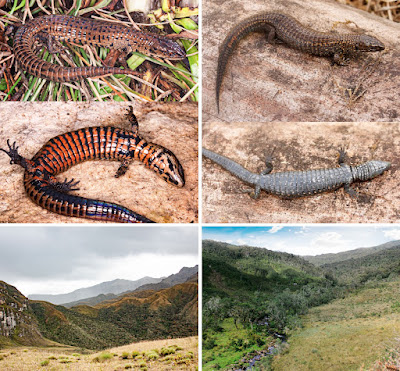 |
| Petracola amazonensis & P. shurugojalcapi Mamani, Vargas, Chaparro & Catenazzi, 2023 facebook.com/LuisMamaniCcasa |
Abstract
The small and semi-fossorial lizards of the genus Petracola are distributed in the Andes from central to northern Peru, on both sides of the dry valley of the Marañon River. Very little is known about the taxonomy of Petracola, but it is presumed that this genus harbors a higher number of species than is currently known. Here, we used a Maximum Likelihood (ML) molecular phylogenetic analysis using concatenated fragments of four mitochondrial genes (12S, 16S, cyt-b, and ND4) and one nuclear gene (c-mos), and the revision of museum specimens, to determine the species diversity of populations of Petracola on both sides of the Marañon River. Our results show that Petracola is a monophyletic genus composed of three independent lineages. The frst lineage includes two undescribed species from the right side of the Marañon River, which we describe herein. The second lineage corresponds to P. ventrimaculatus, and the third lineage includes P. waka which contains undescribed species. Among the two new species from the right side of the Marañon River, P. amazonensis can be identifed by having only the frst superciliary expanded to the dorsal surface, two pairs of genials in contact, absence of a loreal scale, venter orange with black spots forming a transverse band, absence of precloacal pores, and a maximum SVL of 43.0 mm in females; whereas P. shurugojalcapi can be identifed by having two genials in contact, absence of a loreal scale, two discontinuous superciliaries, black venter, dorsum dark brown or black with some cream spots, and an absence of precloacal pores. The two new species increase the diversity of this genus to seven species, four of which inhabit the right side of the dry valley of the Marañon River. However, like other genera of gymnophthalmid Andean lizards, the diversity of Petracola is still underestimated.
Keywords. Andean lizard, Cercosaurini, dry valley, endemic species, northern Andes, Marañon River, semi-fossoriality
 |
| Holotype in life of Petracola amazonensis from Upa (MUBI 11485, SVL= 43.0 mm, TL = 42.3 mm, female). |
Petracola amazonensis sp. nov.
Etymology. The specifc epithet, amazonensis, is an adjective in reference to the type locality in the Department of Amazonas, northern Peru.
Petracola shurugojalcapi sp. nov.
Etymology. The specifc epithet, shurugojalcapi, treated as a noun in apposition, is a combination of two local words: “shurugo” the local name for a gymnophthalmid lizard and “jalcapi” that means “from Jalca” in the Quechua language. The specific name was proposed by the inhabitants of La Jalca Grande.
Luis Mamani, Víctor J. Vargas, Juan C. Chaparro, Alessandro Catenazzi. 2023. Two New Species of gymnophthalmid lizards of the Genus Petracola (Squamata: Cercosaurinae) from the Andes of northeastern Peru, and their phylogenetic relationships. Amphibian & Reptile Conservation. 17(1&2) [Taxonomic Section]: 161-173
